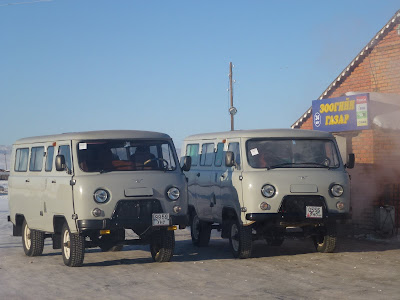This week I had the opportunity to go on my first work trip to rural Mongolia. I went with my work supervisor at the Small and Medium Enterprise (SME) Agency, Suvdaa, and two employees from the Japanese International Cooperation Agency (JICA), one of whom works as a business advisor with our agency. Our destination was the local government area (called a ‘soum’) of Olziit, which is located in the central Mongolian province (called an ‘aimag’) of Arkhangai.
The mayor of the soum and her driver picked the four of us up from Ulaanbaatar (UB) in their Russian jeep, a Vitz. It proved to be a pretty good vehicle, not breaking down on the trip to and from UB. This is pretty rare here, particularly in these freezing temperatures. It would have gotten below -30 degrees Celsius on this journey. It could only go as fast as 80km per hour though, so it did take us a while to drive the 1100km return. The weight in the vehicle probably didn’t help either. With another woman from the soum joining us, there were 7 of us in this small jeep. We fitted five in the backseat at the beginning, and even after the mayor moved to the front seat with the driver and Ikeda-san, I felt like I didn’t gain any more room to myself. But it was snug, which kept me pretty warm throughout the trip.



Our transportation: A Russian jeep (note the Mongolian flag on the steering wheel)


Scenes from the drive
Once we were settled into our accommodation they brought us an early dinner of mutton and potato soup, the same dish I had eaten for lunch at the restaurant we stopped at along the way. I don’t mind this soup that much, it’s actually quite filling and somewhat tasty for a Mongolian national dish. Although I do try to avoid the mutton fat that makes up a large proportion of the meal.
Dinner (lunch being a similar version)


Sunrise
This tour of the soum involved visits to several businesses, including the only cobbler in the soum, who does all his work by hand, and that of a young man trying to start up a dairy business with his five cows. We also had a couple of visitors to our accommodation to talk about developing their businesses. One of these was a woman who needs funding to enhance her felt making business. All of the SMEs and potential business owners had the one hope – that we could assist them in gaining financial support through a business loan. This was not possible: firstly, because the next lot of loans that our Agency allocates to SMEs is at the end of the year, and secondly, we as SME Agency officers do not take part in the selection of soft loan recipients. So we could only provide them with advice in terms of how to prepare their business plan.

In the mayor's office (a common offering in any Mongolian office)
At the boarding school
The drive back to UB was long and exhausting, but it gave me the chance to reflect on the trip, and think about the strength and patience of the Mongolian people. While they may not be patience in the best of times (in supermarket cues they are notorious for cutting in) they are extremely patient by enduring this long and harsh winter, particularly those living in remote rural areas. This strength that they have, both mental and physical, is so admirable. In Australia we talk of people having it tough in the past due to limited technologies and such, but these people living in rural Mongolia are still experiencing such a life. It makes me really appreciate what we have as a developed country. But I believe that while we can teach them all that we can about economic and social development, we can learn a lot from them from them in terms of endurance, patience and personal strength.















No comments:
Post a Comment